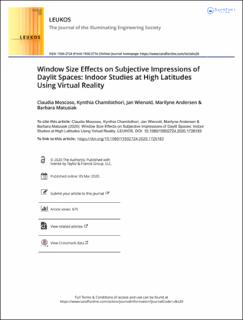| dc.contributor.author | Moscoso Paredes, Claudia Trinidad | |
| dc.contributor.author | Chamilothori, Kynthia | |
| dc.contributor.author | Wienold, Jan | |
| dc.contributor.author | Andersen, Marilyne | |
| dc.contributor.author | Matusiak, Barbara Szybinska | |
| dc.date.accessioned | 2020-10-22T11:02:13Z | |
| dc.date.available | 2020-10-22T11:02:13Z | |
| dc.date.created | 2020-09-25T09:58:52Z | |
| dc.date.issued | 2020 | |
| dc.identifier.issn | 1550-2724 | |
| dc.identifier.uri | https://hdl.handle.net/11250/2684461 | |
| dc.description.abstract | Daylight provision to the indoor space is affected by different building elements that cannot be fully controlled by the users, such as the window size of a space. The dimensions of the fenestration not only affect the lighting levels, but they also affect how the space is perceived by its users. The present study examines three different window sizes via virtual reality, to study how they affect the perception of both a small and a large space at high latitudes. Additionally, two context scenarios (socializing and working), as well as three different sky types (overcast sky and clear skies with either high or low sun angle) were evaluated. The experimental study applied a mixed design with within-subjects and between-subjects factors. A total of 150 participants evaluated the scenes using a Likert-type scale to rate eight different subjective attributes. The statistical results showed that both window size and space type significantly affect the participants’ spatial perception, as well as their satisfaction with the amount of outside view. Larger windows led to more positively evaluated spaces for all studied attributes. Moreover, a significant interaction was found between window size and type of space for the satisfaction with the amount of view in the space, indicating that the window size was dependent on the type of space in which the windows are located. Specifically, the window sizes were rated higher in the small space than in the large space for the evaluation of amount of view. The findings show that window size affects how people perceive a space, and additionally, that other spatial features, such as space type, affect window size preferences. | en_US |
| dc.language.iso | eng | en_US |
| dc.publisher | Wiley | en_US |
| dc.rights | Attribution-NonCommercial-NoDerivatives 4.0 Internasjonal | * |
| dc.rights.uri | http://creativecommons.org/licenses/by-nc-nd/4.0/deed.no | * |
| dc.title | Window Size Effects on Subjective Impressions of Daylit Spaces: Indoor Studies at High Latitudes Using Virtual Reality | en_US |
| dc.type | Peer reviewed | en_US |
| dc.type | Journal article | en_US |
| dc.description.version | publishedVersion | en_US |
| dc.source.journal | LEUKOS The Journal of the Illuminating Engineering Society of North America | en_US |
| dc.identifier.doi | 10.1080/15502724.2020.1726183 | |
| dc.identifier.cristin | 1833338 | |
| dc.description.localcode | © 2020 The Author(s). Published with license by Taylor & Francis Group, LLC. This is an Open Access article distributed under the terms of the Creative Commons Attribution-NonCommercial-NoDerivatives License (http://creativecommons.org/licenses/by-ncnd/4.0/), which permits non-commercial re-use, distribution, and reproduction in any medium, provided the original work is properly cited, and is not altered, transformed, or built upon in any way. | en_US |
| cristin.ispublished | true | |
| cristin.fulltext | original | |
| cristin.qualitycode | 1 | |

